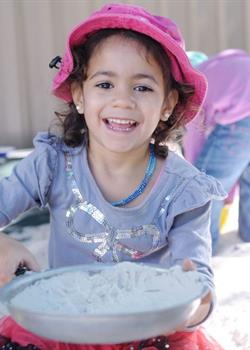Playing with sand
Playing with sand helps kids learn about shape, weight and capacity as they fill containers with sand and investigate changes, like what happens to the sand when water is added.
Sand words
Words that relate to sand will be more accessible to your child when they are interacting with it. Words like pour, trickle, sift, scoop, heap, dig, shovel, slide, mound, bury, tunnel, pat, mould, squeeze, flatten, damp, heavy, light, more, less, same, equal, absorb, flow, solid, liquid, wet, dry, course, fine.
Get experimental
Sand is a great material for kids to explore. It can be shovelled, scooped, poured, trickled, sifted, patted, moulded, poked, piled, smoothed, flattened, jumped in, tunnelled through, drawn in and decorated.
Encourage your child to explore different ways to play with sand by asking questions like:
- "What could you do to stop the water from soaking into the sand?"
- "How could you stop the sandcastle from falling down?"
- "Does this bucket feel heavier than that one?"
- "What do you think is making the sand warm today?"
- "Is the sand heavier or lighter when you add water?"
If your child is ready for further investigation, try these ideas:
- Encourage children to estimate how many cups of sand will fill a saucepan; then ask them to find out if they were right.
- Experiment to find out how much water makes the sand damp, wet or sloppy.
- Add a sheet of plastic to hold water for dams or rivers.
- Find out what happens when you pour water into a hole in the sand.
Playing with water
Playing with water builds curiosity, investigation skills and problem solving.
Water play also helps children discover mathematical concepts such as volume, full and empty, and the properties of materials (for example, water can be poured).
Water words
New words become useful and real when you use them in context. So playing with water is the ideal time to get that vocabulary working by saying words such as wash, drip, splash, sprinkle, gurgle, trickle, pour, flow, froth, foam, bubble, gush, soak, fill, empty, rise, fall, freeze, mist, evaporate, absorb, dissolve, wet, warm, hot, cold, icy, freezing, dripping and damp.
Make a splash
Water can be splashed, trickled, poured, sprinkled, stirred, beaten, paddled in, run through, painted with and used for simple science experiments, like exploring the ideas of floating and sinking, solid and liquid.
Asking questions is a great way to get your child thinking. Ask questions like:
- "Do you think that will float?"
- "Will that sink?"
- "Is that full or empty?"
- "What will happen if you … ?"
- "How does that water feel?"
Water play ideas
You can create some variety in the games you play with your child with buckets, cups, spoons, sponges, funnels and any brightly coloured containers from around your home.
Here are some water play ideas:
- Explore floating and sinking with a variety of objects.
- Use squeeze bottles to see how far water squirts.
- Get different materials, like sponges or sand, and see how each absorbs water.
- Add detergent, veggie oil or food colouring to change the properties of water.